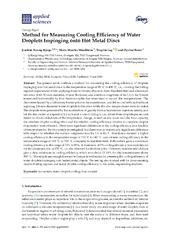Method for measuring cooling efficiency ofwater droplets impinging onto hot metal discs
Peer reviewed, Journal article
Published version

Åpne
Permanent lenke
https://hdl.handle.net/1956/19375Utgivelsesdato
2018-06-09Metadata
Vis full innførselSamlinger
Originalversjon
https://doi.org/10.3390/app8060953Sammendrag
The present work outlines a method for measuring the cooling efficiency of droplets impinging onto hot metal discs in the temperature range of 85 °C to 400 °C, i.e., covering the boiling regimes experienced when applying water to heated objects in fires. Stainless steel and aluminum test discs (with 50-mm diameter, 10-mm thickness, and a surface roughness of Ra 0.4 or Ra 3) were suspended horizontally by four thermocouples that were used to record disc temperatures. The discs were heated by a laboratory burner prior to the experiments, and left to cool with and without applying 2.4-mm diameter water droplets to the discs while the disc temperatures were recorded. The droplets were generated by the acceleration of gravity from a hypodermic injection needle, and hit the disc center at a speed of 2.2 m/s and a rate of 0.02 g/s, i.e., about three droplets per second. Based on the recorded rate of the temperature change, as well as disc mass and disc heat capacity, the absolute droplet cooling effect and the relative cooling efficiency relative to complete droplet evaporation were obtained. There were significant differences in the cooling efficiency as a function of temperature for the two metals investigated, but there was no statistically significant difference with respect to whether the surface roughness was Ra 0.4 or Ra 3. Aluminum showed a higher cooling efficiency in the temperature range of 110 °C to 140 °C, and a lower cooling efficiency in the temperature range of 180 °C to 300 °C compared to stainless steel. Both metals gave a maximum cooling efficiency in the range of 75% to 85%. A minimum of 5% cooling efficiency was experienced for the aluminum disc at 235 °C, i.e., the observed Leidenfrost point. However, stainless steel did not give a clear minimum in cooling efficiency, which was about 12–14% for disc temperatures above 300 °C. This simple and straightforward technique is well suited for assessing the cooling efficiency of water droplets impinging onto heated metal objects. The test rig also worked well for demonstrating droplet boiling regimes and water droplet cooling efficiency to fire safety engineering students.
